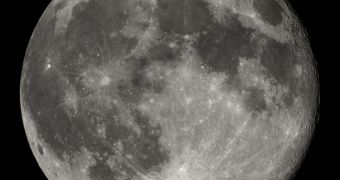According to the conclusions of a new scientific study, it would appear that the Moon is younger than researchers first calculated. It's either that, or it evolved in different patterns over the past few billion years. It may even be that it collided with another Moon.
The widely-accepted hypothesis at this point is that the object formed an estimated 4.5 billion years ago, in the earliest days of the solar system. It was the main result of a massive space collision that involved the early Earth and a Mars-sized object.
At first, the Moon's surface was an ocean of molten lava, which took tens of thousands to a few million years to solidify. However, not all scientists believe that it was possible for such a vast volume of material to become solid in such a short geological lifespan.
During the NASA Apollo lunar landings, astronauts collected a large variety of rocks from the surface of Earth's natural satellite. These artifacts were kept at the Johnson Space Center (JSC), in Houston, Texas, and represent one of the primary objects researchers base their theories on.
A type of rocks called ferroan anorthosites – which are widely believed to be the first rocks to form on the Moon – were the main target of investigation. These anorthosites made up the first and oldest lunar crust, therefore analyzing them would hold the most relevance to this line of study.
In order to make the most precise age measurements, investigators analyzed lead, samarium and neodymium isotopic ratios in carefully-purified rock samples selected from what Apollo astronauts returned to Earth, Space reports.
Analyzing isotopic proportions inside materials is one of the main methods used to determine age in ancient objects. Such a technique is also used when analyzing for example how our planet's atmosphere looked like when Earth was very young.
“After many years of trying, we have found a way to reliably date the ages of lunar crustal rocks with high precision,” US Department of Energy (DOE) Lawrence Livermore National Laboratory (LLNL) planetary scientist Lars Borg explains.
“We can apply this technique to address many questions regarding the timing of ancient events on the Moon,” adds the expert, who was also the lead author of a new study detailing the findings. The work is detailed in the August 17 issue of the top journal Nature.
The new technique indicated that Moon rocks crystallized about 4.36 billion years ago, which is way later than the object is thought to have formed. There are several possible explanations for this discrepancy, of which one is that magma covering the Moon solidified a lot slower than first thought.
Another explanation is that Earth had a second moon, which slammed into the current one sometime after the former was created. The effects of such an impact explain the geological peculiarities that currently characterize the Moon.

 14 DAY TRIAL //
14 DAY TRIAL //